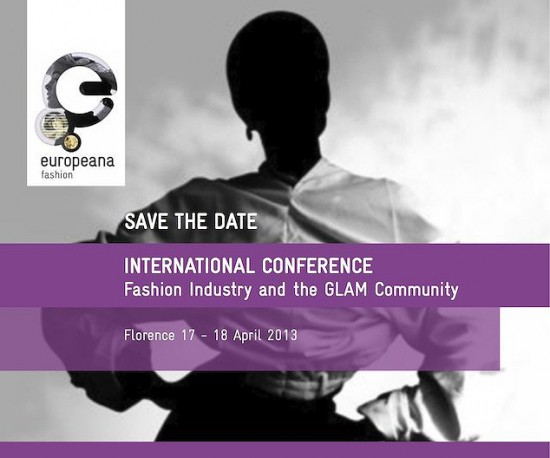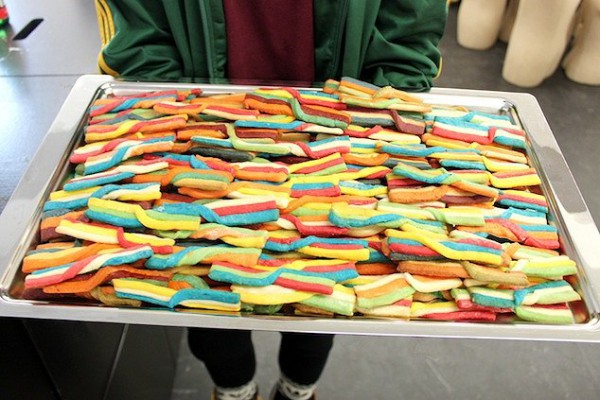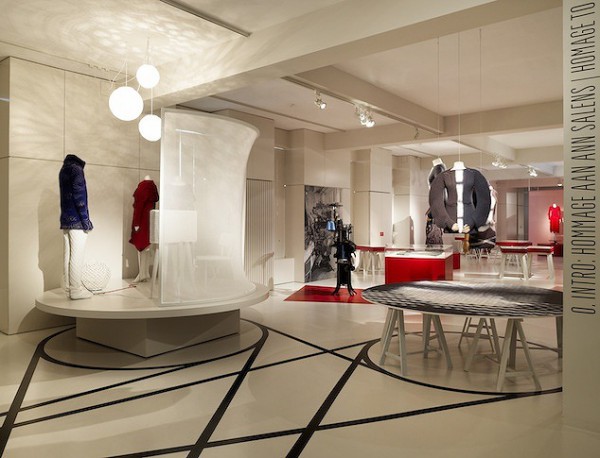See the Silks & Prints from the Abraham Archive in less time than what you need to kiss a few friends and have a glass of wine!
See the Silks & Prints from the Abraham Archive in less time than what you need to kiss a few friends and have a glass of wine!

On April 17th & 18th, Europeana Fashion will host an international fashion conference in Florence, Italy. Titled ‚ÄúFashion Industry and the GLAM Community‚ÄĚ, the conference will explore the creative synergies between the fashion industry and the heritage sector.
The conference is bringing together speakers from the field, who will explore the limits and opportunities of the relationship between the industry and the heritage sector in three sessions. Among the speakers are Kaat Debo (Director, MoMu Antwerp), Valerie Steele (Director, Museum at FIT New York) and Diane Pernet (Founder, A Shaded View on Fashion). Registration and attendance of the conference is free.

We are happy to present this tasty collaboration with Piva, the Provincial institute for horeca training, for the opening reception of our Silks & Prints exhibition this evening. The students of Piva made these scrumptious cookies for our guests tonight to enjoy during the vernissage. Just like the campaign image, the cookies are not only wonderful, but colorful as well! Whether you like eating sweet or salty, our cookies are made for every palette! Below a selection of pictures from the work in progress. Thank you Piva!
We are very proud to present our new exhibition Silks & Prints from the Abraham Archive: Couture in Colour. During the 1950s and 1960s, the couturiers Christian Dior, Hubert de Givenchy, Yves Saint Laurent and Cristóbal Balenciaga all worked together with the Swiss firm, Abraham, for their exclusive fabrics. This company was specialized in printing silks. Today, the Abraham archives, an impressive collection of sample books, couture photographs and textiles, are housed at the Swiss National Museum in Zurich.
MoMu recaptures and expands on the exhibition, Soie Pirate: The Abraham Textile Archive Zurich, held from 22/10/2010 ‚Äď 20/02/2011, at the Swiss National Museum in Zurich. Silks & Prints from the Abraham Archive: Couture in Colour, tells both the story of the Abraham company and that of European couture, art and luxury throughout the 20th century.
MoMu complements the original exhibition and completes it with couture silhouettes by Dior, Givenchy, Yves Saint Laurent and Balenciaga. The exhibition reveals which colourful textile prints were created by the Abraham firm. Contemporary designers, including Dries Van Noten, Diane Von Furstenberg and Peter Pilotto, were invited to experiment with Abraham prints.
During the 1930s, Abraham was under the leadership of Gustav Zumsteg. He regularly stayed in Paris and became acquainted with the art dealers Aimé and Margherie Maeght. They introduced him to a number of influential artists, from Georges Braque to Marc Chagall and Alberto Giacometti. Zumsteg began collecting art at the same time that he was designing textiles. In Paris, he also met couturiers, such as Pierre Balmain, Christian Dior and Elsa Schiaparelli. These great names from the art and fashion worlds had a considerable influence on Zumsteg’s artistic creations. In a short period, Zumsteg became a key figure in manufacturing textiles for haute couture.
In 1947, Christian Dior used Abraham fabrics for the New Look, the new silhouette after World War II, which once again presented luxury as the image of fashion and which enjoyed enormous success. Abraham’s rich weaves with deep colours were the perfect match for Dior. Ten years later, at Christian Dior’s funeral, Zumsteg met Yves Saint Laurent: it would be the beginning of a 40-year collaboration.
After the arrival of prêt-à-porter, from the 1960s, the demand for top-quality silks tapered off. Zumsteg adapted to the new situation and began designing prints for the high end of the ready-to-wear market. The company did continue, albeit on a smaller scale, to produce silk prints for the Scandinavian and Middle Eastern markets. In 1995, when their close collaboration with Yves Saint Laurent came to an end, the future of the Abraham company became especially uncertain. The firm finally closed its doors in 2002.
In the summer of 2007 the Hulda und Gustav Zumsteg Foundation donated the textile archive of Zurich company Abraham Ltd. to the Swiss National Museum, their archives are rightly considered a national heritage. The Zurich Silk Association came along as an additional partner and got involved in studying the archive and in presentation and publication.
Silks & Prints from the Abraham Archive: Couture in Colour will run from March 13th until August 11th 2013.
Imagine a place where you can discover centuries of fashion, from the latest styles of Europe’s 17th century courts to the runway looks of fashion week. Browse through thousands of objects, photos, videos, magazines, books, exhibitions, sketches and catalogues, all about fashion.
This place will be called Europeana Fashion and it will be an online portal to the collections of Europe’s leading fashion institutions, including MoMu’s. In addition to providing content for the portal, MoMu is also playing a coordinating role in the project.
Gigantic silver spheres mirroring a Magritte-style cloud path was the setting of Raf Simons‚Äė second ready-to-wear collection for the house of Dior that was presented last Friday in Paris. For Autumn-Winter Raf Simons focuses on the notion of memory and how it shapes the nature of design at the house of Dior, how this works for himself and how this once worked for Christian Dior.
‚ÄúThis collection is more connected to passions we share‚ÄĚ says Raf Simons. ‚ÄúLike a real interest in art ‚Äď Christian Dior started his career as a gallerist and represented both Dali and Giacometti early on. The connection to certain periods of time is also significant, his obsession with the Belle Epoque in his case, the Mid-Century modern in mine. here the connections made are important, the very idea of them rather than what they are made to; the attraction and obsession is the significant part.‚ÄĚ
Simons collaborated with The Andy Warhol Foundation for the Visual Arts in the collection. The early hand drawn work from the 1950s of the artist Andy Warhol is found as a recurring motif of the mid-century style printed or embroidered on the clothing and accessories. ‚ÄúFor me Warhol made so much sense,‚ÄĚ says Simons of this collaboration. ‚ÄúI was interested in the delicacy and sensitivity in the early work he did, I was drawn to that graphic style naturally in this collection. It was that notion of hand work and personal signature that fitted throughout.‚ÄĚ
The MoMu Collection ‚ąí both historic costumes and contemporary fashion ‚ąí has grown considerably in recent years, to a total of 22,142 pieces in 2012. This remarkable increase illustrates the expanding reputation of our museum and the high regard for the work of the museum in the fashion field. The collection has to date been preserved on site in a climate-controlled depot of 620 m¬≤, including 294 running metres of clothing.
Because the MoMu collection is growing fast each year, the museum now faces a serious shortage of space. The only way to better and more responsibly house the current collection, as well as provide an appropriate home for future pieces, is to provide additional storage space.
The Province of Antwerp has signed a general contract with KatoenNatie for the rental of flexible storage space. This is a completely climate-controlled depot that meets all criteria for museum conservation.
Here is an advance taste of the process of moving part of our collection to its new home.
The upcoming expo ‚ÄėSilks & Prints from the Abraham Archive ‚Äď Couture in Colour‚Äô has captured the attention of our beloved neighbors. German ELLE magazine has mentioned the expo in their March 2013 issue and uses words like ‚Äėgenius‚Äô and ‚Äėlegendary‚Äô to show their fondness for the Abraham archives. It looks like we are not the only ones who are excited about the expo!
MoMu is proud that the International Woolmark Prize 2013 went to Christian Wijnants, following in the footsteps op people like Yves Saint Laurent and Karl Lagerfeld. The award ceremony was presented at an event last Saturday evening during London Fashion Week. The judging panel included oa Victoria Beckham, Donatella Versace, Diane von Furstenberg, Franca Sozzani and Tim Blanks. More than 70 nominees were initially selected by various fashion industry nominating bodies from across the globe. The award is relaunched by Woolmark to help promote outstanding design talent around the world and the innovative use of fibre and Merino wool.
Wijnants is one of Belgium’s most beloved knitwear designers with a very well developed innovative technique and artistic approach to knitwear. He has such a passion for knitwear that experimenting and trying out new techniques are the things he loves the most. Wijnants used to teach at the Fashion Department of the Royal Academy in Antwerp, stimulating students to play and experiment with knitwear in their collections.
Installation ‘Hommage to Ann Saelens’ by Hilde Frunt (left) and Christian Wijnants (right) at the ‘Unravel: Knitwear in Fashion’ exhibition, 2011, Photography: Frederik Vercruysse

In 2011, MoMu organized the ‚ÄėUnravel: Knitwear in Fashion‚Äô exhibition with an installation of 3 new dresses by Wijnants commissioned for the exhibition. For these silhouettes Wijnants experimented with different techniques he used in his A/W 2005-06 and A/W 2008-09 collections, blending them into a new look. More specifically, he combined the ‚Äėopen‚Äô and circular knitwear, used in his Ann Salens tribute collection of A/W 2005-06 (made to look like crochet) with the tie-n-dye techniques used in his A/W 2008-09 collection. He then turned the dresses inside out to show the purl side, which gives a pixelated effect. On top of that, he unraveled a part of the dress after dyeing it, reuniting it by hand on the machine.
Taking these experiments as the basis for his further development and play with these themes, he developed the collection which was granted the International Woolmark Prize.
While some of us are dressing and parading down the street in the spirit of Carnival, Christin Ho, our library colleague, shares some interesting thoughts on this theme of the year: Carnival in the MoMu-library!
Going through our turn-of-of-the-century magazines we noticed the juxtapositions of attitudes towards celebrating Carnival. The collective mix of curiosity and enthusiasm on the one hand, and boredom and skepticism on the other might not be so atypical as we may think during this time of the year in the past.
In March 1905 Bruxelles F√©minin highlighted the various festivities that were held in Brussels for Carnival, especially ‚Äúles batailles de confetti‚ÄĚ were regarded as hotbeds for dissolute behavior. The magazine at times mentioned the importance of masquerades, at other times it questioned the long tradition of wearing disguises because things got pretty wild at these events. Although drunken brawls were quite normal and linked to this feast, Bruxelles F√©minin complained about the irresponsible acts of drunken citizens that fanned the flames of discontent. To support this message, silly illustrations with ‚Äď sometimes quite sarcastic ‚Äď commentary were published.
Unlike Bruxelles Féminin, in January 1887 Revue de la Mode looked forward to the fancy-dress balls during Carnival celebrations. Fashion notes with advice on dressmaking and the best hairstyles were offered. The pleasure of appearing incognito did not mean that attendees could do whatever they pleased, great respect for the standard codes of dress and behavior remained important.
The upcoming expo ‚ÄėSilks & Prints from Abraham ‚Äď Couture in Colour‚Äô not only tells the story of the legendary Swiss Abraham company and that of European couture, art and luxury throughout the 20th century. It also reflects on the person of Gustav Zumsteg (director of Abraham during the 1930s) and how he became a key figure in manufacturing textiles for haute couture.
Zumsteg was friend and collaborator to the haute couture designers like Christian Dior, Hubert de Givenchy, Cristobal Balenciaga and an intimate of Yves Saint Laurent. He considered his friendship with Saint Laurent a ‚Äúcoup de foudre‚ÄĚ with a shared love for books, art and music. Their closeness did intensify the design process and their collaborations were always inventive and original.
Yves Saint Laurent upon Zumsteg‚Äôs death: ‚ÄúGustav Zumsteg was my ally, my friend and my collaborator for some 45 years, I used his fabric in my most beautiful dresses. His talent was a never-ending source of inspiration. I owe him many unforgettable moments.‚ÄĚ
Best Wishes for the New Year!
Check out our programme of future exhibitions for 2013!